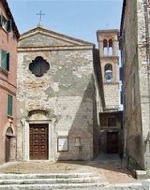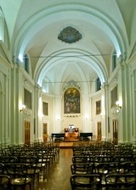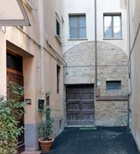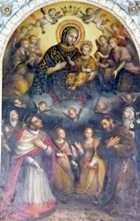



There was an oratory dedicated to the Virgin on this site from at least the early 14th century. It became a parish church in 1366, when the parish of San Stefano del Castellare was split into two. The facade owes its current asymmetric appearance to the building of the adjacent rectory at that time.
A small community of Observant Dominican friars lived in a convent next to the church from 1429 until the end of the 15th century. The plaque over the door to the rectory (which covers part of the original facade of the church) refers to work that was financed by a donation of that date, probably in relation to the establishment of this community. This donation was made by Ercolano di Giorgio, for his own soul, that of his parents and his wife Susanna, and that of everybody who passed the church on 17th November, 1429.

The church was extensively remodelled in 1717, possibly in response to a miracle associated with a venerated image of the Madonna (see below) that was then housed here. It was venerated each year on the Feast of the Birth of the Virgin (8th September).
Another venerated image in the church, which is a relief of the Madonna and Child, was originally on the wall of a nearby house owned by Cesare Cocchi. It was translated to the church in 1796 after it performed a series of miracles. It is now in a niche in the 3rd bay on the right.
The parish was annexed to that of Santa Croce in 1833. The church, which now belongs to the Istituto Musicale Girolamo Frescobaldi, is known as the Auditorium Marianum and is sometimes open for concerts.
Interior
Madonna di Costantinopoli (1614)

Adoration of the Magi (1717)
This panel [where ??] is signed by Giacinto Boccanera and dated by inscription.
Panels (18th century)
These panels, which are attributed to Cristoforo Gasperi, depict:
-
✴the Nativity (in the 1st bay on the left);
-
✴the Birth of the Virgin (in the 1st bay on the right);
-
✴the Crucifixion (in the 2nd bay on the left); and
-
✴the Madonna and Child, set on a hillside (in the 2nd bay on the right);
-
✴the Communion of St Peter (in the 3rd bay on the left); and
-
✴Pentecost (in the 3rd bay on the right).
This setting of the Madonna and Child above was a reference to the dedication of the church, which probably derives from Proverbs 8:25, “Before the mountains had been shaped, before the hills, I was brought forth”. The panel was raised each year on the Feast of the Birth of the Virgin (8th September) to reveal a venerated statue of the Virgin. [Are they still here?]

